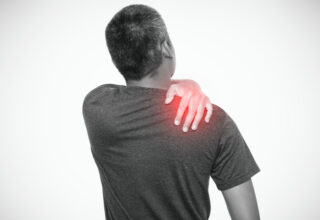Pain in the back of ribs can have many reasons. It can be due to an injury, but sometimes it can point towards an underlying cause such as osteoporosis, gallstones, or a lung condition.
The pain can range from mild to severe and may feel sharp or dull.
Most of the time the pain gets better without intervention and sometimes it requires specialist care.
Let’s take a closer look at some common causes of back rib pain, their symptoms and treatment options, and when it’s time to see a doctor.
Common Causes of Back Rib Pain
1. Injury
An injury is a very common cause of back rib pain. You may have a rib injury due to a sudden movement or heavy lifting, a fall, car or bike accident, or a sports-related incident.
Rib injury can cause pain (that worsens with breathing, coughing, or movement), tenderness, swelling, or bruising in the affected area.
Common rib injuries can be:
- Bruised rib
- Pulled muscles
- Fractured or broken rib
If the pain is severe or lasts for more than a few days, it may be due to a broken rib. Your doctor may order an X-ray, or CT scan of the chest to diagnose the injury.
Most minor injuries are healed with rest, and pain relief medications. In severe cases, surgery may also be needed.
2. Intercostal Muscle Strain
The intercostal muscles are present between your ribs and help with breathing. An intercostal muscle strain occurs due to injury to these muscles, which is often due to strenuous physical activity such as heavy lifting or intense exercise.
Intercostal muscle strain can cause symptoms like:
- Sharp and severe pain in the upper back, or ribs
- Muscle stiffness and tension in the upper back
- Spasm in intercostal muscles
- Tenderness around ribs
- Limited range of motion in your torso
Treatment usually involves rest, pain medications, heat and cold therapy, and physical therapy.
3. Costochondritis
Costochondritis is the inflammation of the cartilage that connects your ribs to your sternum (breastbone). It’s a common condition especially among the adults of age from 40 to 50.
It usually causes sharp pain in the chest and sometimes back of the ribs. The pain usually gets worse with movement, deep breathing, or lying down.
Treatment options may include:
- Applying heat to ease the pain
- Using local or oral pain relief medications
- Applying capsaicin cream
- Physical therapy
In most cases symptoms improve within a few weeks. However, the symptoms can be similar to a heart condition, so it’s best to consult a doctor for proper diagnosis and treatment.
4. Osteoporosis
Osteoporosis is a condition that causes bones to become weak and brittle. It makes them fragile and more likely to break—sometimes even due to less intense movements or activities.
Due to osteoporosis bones lose essential minerals like calcium, which reduces their mineral density and strength.
This condition is common in older adults, especially women. Although many people might not experience symptoms of osteoporosis, if they do, symptoms include soreness and pain (rib pain in case a small fracture occurs).
Doctors usually diagnose osteoporosis with X-ray or bone density scan and may also assess kidney and thyroid functions.
Treatment may include:
- Gentle strength training
- Reducing alcohol consumption
- Quitting smoking
- Taking calcium and vitamin D3 supplements
- Using medications that help protect bone density and prevent fractures
5. Gallstones
Gallstones or gallbladder stones are the hardened deposits formed in the gallbladder–a small pear shaped organ that helps with digestion.
Gallstones don’t always cause symptoms but sometimes they move and block bile ducts, causing sharp pain and other complications.
The pain from gallstones appear in the upper right abdomen just under your ribs, and can radiate to the back—especially between shoulder blades. (Learn more about back pain between shoulder blades).
This pain is often triggered by eating a fatty meal and can last anywhere between a few minutes to several hours. It may also be accompanied with other symptoms like:
- Nausea
- Vomiting
- Jaundice (yellowing of skin and eyes)
If the bile duct gets blocked it can become serious and need urgent medical attention. So if you have severe or persistent abdominal pain, especially with jaundice, get immediate medical care.
6. Fibromyalgia
Fibromyalgia is a long-term condition that causes widespread pain throughout the body, including muscles, joints, and bones. It often affects women more than men and its exact cause isn’t fully understood,
People with fibromyalgia may also experience:
- Fatigue and low energy
- Headaches
- Numbness or burning sensations in the hand or feet (paresthesia)
- Anxiety or depression
- Difficulty processing and remembering information
Doctors may recommend different treatment options for fibromyalgia, such as:
- Improving sleep quality
- Practicing relaxation and stress management techniques
- Cognitive behavioral therapy (CBT)
- Medications like antidepressants or anticonvulsants
7. Pulmonary Embolism
Pulmonary embolism happens when a blood vessel in the lungs becomes blocked, often due to a blood clot.
It usually starts with a clot forming in the leg. If that clot travels through the blood stream and reaches the lungs, it can block the blood flow and cause sudden and severe symptoms.
In addition to pain in the back or ribs, it can cause symptoms like:
- Sudden shortness of breath (most common)
- Coughing (sometimes bringing up blood or blood-streaked mucus)
- Chest pain that gets worse with breathing
- Rapid or irregular heartbeat
- Excessive Sweating
- Headache
- Lightheadedness, dizziness, or fainting
- A feeling of anxiety
Pulmonary embolism is a serious, life-threatening condition that needs urgent medical care.
Treatment usually involves blood thinning medications (anticoagulants). These help prevent existing clots from getting bigger and new clots from forming.
In some cases, especially when anticoagulants are not suitable for a person, other treatments may also be used.
8. Lung Conditions
There are some lung conditions that can also cause back rib pain. These include:
Pleurisy—inflammation of the lining of the lungs. It can cause sharp pain in the chest, back ribs, and shoulders which gets worse with breathing or coughing.
Pleurisy can be caused by many underlying issues and treatment depends on the reason that’s causing it.
Lung cancer is another possible cause of persistent chest or rib pain. It’s a serious, life-threatening condition.
According to the World Health Organization (WHO) lung cancer is the leading cause of cancer-related deaths worldwide.
In addition to pain, lung cancer can cause symptoms like:
- Chronic cough or coughing up blood
- Shortness of breath
- Unexplained weight loss
- Fatigue
The treatment depends on the type and stage of the cancer. It may involve surgery, chemotherapy, or radiation therapy.
When to See a Doctor
Back rib pain often gets better without any interventions, but it’s important to check in with a doctor if your pain:
- Gets worse over time or doesn’t improve after a few days of home care
- Is making it hard for you to breathe, move comfortably, or do your daily activities
- Follows an accident or injury
- Accompanied by symptoms like fever, chills, vomiting, nausea, coughing, or other symptoms
You should seek medical help immediately or go to the nearest A&E department if:
- Your pain is extremely severe or comes suddenly
- You experience chest pain, difficulty breathing, or shortness of breath
- You notice jaundice (yellowing of the skin and eyes)
- You feel generally unwell or symptoms worsen quickly over a few hours
Tips to Relieve Back Rib Pain at Home
For mild cases related to strain or posture, a few simple things can help:
- Rest (but avoid staying still for too long)
- Apply a heat or cold pack to ease soreness
- Take over-the-counter pain relievers like paracetamol or ibuprofen
- Sit and stand upright—avoid slouched posture
- Stay hydrated and take a healthy balanced diet
- Try physical therapy
Final Thoughts
Back rib pain can have many causes—from simple muscle strain to more serious conditions like gallstones or lung disease. Mild pain often improves with rest and self-care but severe or persistent pain shouldn’t be ignored.
If you’re not sure what’s causing your pain, check in with a doctor. Early assessment and management can help prevent complications.








